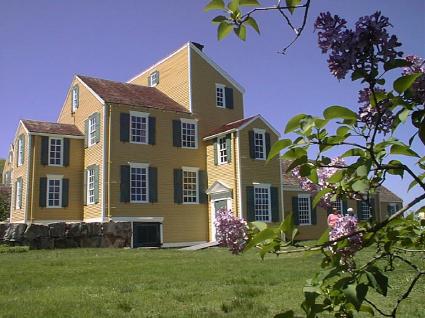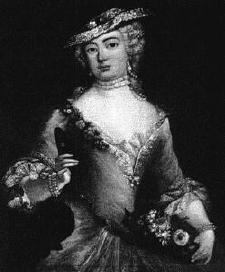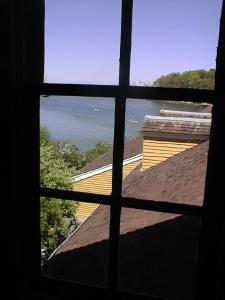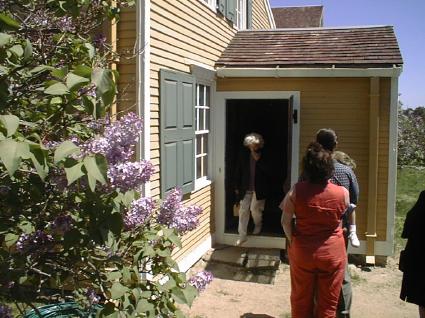| Wentworth-Coolidge Mansion |

Tour New Hampshire's Royal Mansion
Fascinating tales and fascinating architecture surround New England's longest-reigning Royal Governor Benning Wentworth. His home still survives on Little Harbor and we have the complete text of the house brochure. Here's the story in a nutshell. Now you have to visit to get the whole picture.
The rambling yellow Wentworth Coolidge mansion was built by Royal Governor Benning Wentworth (1696-1770) in the mid-eighteenth century. Benning Wentworth governed New Hampshire from 1741 to 1767 – the longest serving royal governor in British America. His house, both awkward and elegant, was the political and social heart of late colonial New Hampshire.
Political Career
 A native of Portsmouth, Wentworth graduated from Harvard in 1715 and began his career as a Boston merchant, shipping lumber to Spain. Wentworth faced bankruptcy in 1738 when the Spanish government defaulted on payments it owed him. Friends in England persuaded Wentworth’s creditors that their best hope of repayment lay in securing him a government position. In 1741 Wentworth was appointed royal governor of New Hampshire, which had just been redefined as a separate, enlarged province. In 1743 he purchased the post of Surveyor General of the King’s Woods, giving him a regulatory role in providing masts to the Royal Navy. Wentworth issued numerous town charters stretching into today’s Vermont (he named Bennington for himself). This put him in a position to supplement his modest pay as governor through fees and speculation in timber and land. In every new township he granted, Wentworth reserved a 500-acre “farm” for himself, and set aside land for the Anglican Society for the Propagation of the Gospel.
A native of Portsmouth, Wentworth graduated from Harvard in 1715 and began his career as a Boston merchant, shipping lumber to Spain. Wentworth faced bankruptcy in 1738 when the Spanish government defaulted on payments it owed him. Friends in England persuaded Wentworth’s creditors that their best hope of repayment lay in securing him a government position. In 1741 Wentworth was appointed royal governor of New Hampshire, which had just been redefined as a separate, enlarged province. In 1743 he purchased the post of Surveyor General of the King’s Woods, giving him a regulatory role in providing masts to the Royal Navy. Wentworth issued numerous town charters stretching into today’s Vermont (he named Bennington for himself). This put him in a position to supplement his modest pay as governor through fees and speculation in timber and land. In every new township he granted, Wentworth reserved a 500-acre “farm” for himself, and set aside land for the Anglican Society for the Propagation of the Gospel.
A Hierarchical and Political House
When the legislative assembly refused Wentworth’s requests to purchase an official governor’s residence in central Portsmouth, Wentworth moved to family property at Little Harbor in 1753. The mansion’s appearance is a result of an unusual construction history. His carpenters cobbled together several pre-existing buildings into the curious house we see today. It encompasses three wings, each with its own entrance and staircase: a servants’ wing, a family wing, and an entertainment wing. Much behind-the-scenes political activity was probably accomplished at gatherings here. Wentworth retired from the governorship in 1767, and was succeeded by a nephew, John Wentworth (1737-1820), New Hampshire’s last royal governor.

Domestic Life
Relatively little is known about Wentworth’s domestic life. Myths are numerous, facts are few. He hired farmers to cultivate the extensive land around the house, and housekeepers to care for the sprawling mansion. A French-born tavern keeper regularly rode out from Portsmouth to shave the governor and sometimes to cook in a special French kitchen that still survives in the mansion. Wentworth was an advocate of the Anglican Church in a predominantly Calvinist region. He outlived his sons, and his first wife died in 1755. The lonely governor then married Martha Hilton (c. 1737-1805) in 1760. Daughter of a genteel widow, Martha had been serving as housekeeper at the mansion.
Successive owners
 Upon Wentworth’s death in 1770, Martha Hilton Wentworth inherited the property. Martha lived in the mansion for thirty-five years, marrying a new husband, the English-born Michael Wentworth (1719-1795) a few months after Benning Wentworth’s death. Their daughter, also named Martha, inherited the house in 1805, auctioned the contents in 1816, and sold the property to Charles Cushing. For seventy years the Cushings and their kin, the Israel family, owned the mansion. During their occupancy the mansion was opened to the public as a historic shrine, an early example of this practice.
Upon Wentworth’s death in 1770, Martha Hilton Wentworth inherited the property. Martha lived in the mansion for thirty-five years, marrying a new husband, the English-born Michael Wentworth (1719-1795) a few months after Benning Wentworth’s death. Their daughter, also named Martha, inherited the house in 1805, auctioned the contents in 1816, and sold the property to Charles Cushing. For seventy years the Cushings and their kin, the Israel family, owned the mansion. During their occupancy the mansion was opened to the public as a historic shrine, an early example of this practice.
The Coolidge Family
In 1886 J.Templeman Coolidge of Boston bought the house as a summer home for his family. Coolidge was a Harvard graduate, an accomplished amateur artist, and a recreational sailor, who found the place an ideal summer home. In Boston he promoted arts education, was a trustee of the Museum of Fine Arts and the Boston Athenaeum, and served on many other art boards. He and his artist friends and associates constituted a creative summer colony here at Little Harbor.
Visitors included John Singer Sargent, Edmund Tarbell, and Isabella Stewart Gardner. Over the years Coolidge added a small guest wing at the north-east corner of the house, a low servants’ wing at the north-west corner of the house, and the shingled carriage house at the top of the sloped lawn. A former hen house was converted to a guesthouse. Later this and scattered small parcels were sold to friends and acquaintances for their summerhouses. Coolidge died in 1945, and his widow, Mary Abigail Parsons Coolidge, offered the mansion and remaining property to the State of New Hampshire. Governor Hugh Gregg and the executive council accepted the property in 1954.
Restoration, Renovation and Care
 The state placed the mansion under the care of the Forestry and Recreation Commission, later the Division of Parks and Recreation. In 1980, Governor Hugh Gallen appointed a volunteer civilian commission to help furnish the mansion and administer its programs. With assistance from the Division of Historical Resources, the Division of Parks and Recreation and the Wentworth-Coolidge Commission have analyzed, restored and maintained the building, located supporting documents, evaluated archaeological resources, researched the landscape, and renovated the carriage house as a visitor center. Recent and current projects include improvement of drainage, installation of climate controls and development of methods to block harmful sunlight. Wentworth-based programs include house tours, an annual lilac festival, and school programs. Coolidge-based programs include art classes and exhibits of contemporary regional art.
The state placed the mansion under the care of the Forestry and Recreation Commission, later the Division of Parks and Recreation. In 1980, Governor Hugh Gallen appointed a volunteer civilian commission to help furnish the mansion and administer its programs. With assistance from the Division of Historical Resources, the Division of Parks and Recreation and the Wentworth-Coolidge Commission have analyzed, restored and maintained the building, located supporting documents, evaluated archaeological resources, researched the landscape, and renovated the carriage house as a visitor center. Recent and current projects include improvement of drainage, installation of climate controls and development of methods to block harmful sunlight. Wentworth-based programs include house tours, an annual lilac festival, and school programs. Coolidge-based programs include art classes and exhibits of contemporary regional art.
In addition to its fifty-eight parks statewide, the New Hampshire Division of Parks and Recreation also maintains thirteen historic sites. They include: the Hannah Dustin Memorial in Boscawan, Endicott Rock in Laconia, Fort Constitution and Fort Stark in New Castle, White Island Lighthouse at the Isles of Shoals, the Robert Frost Farm and the Taylor Sawmill in Derry, the Pierce Homestead in Hillsborough, Tip-Top House on Mount Washington, the Daniel Webster Memorial in Franklin, the John Wingate Weeks Historic Site in Lancaster, the Governor John Wentworth site in Wolfeboro, the Wentworth Coolidge Mansion.

Hours and Contact Information
The grounds are open to the public year-round from dawn to dusk. Tours of the mansion are given from mid-May to Labor Day, Wednesday to Sunday; weekends only from September to mid-October. The site may be rented for meetings, weddings and other functions. The Wentworth-Coolidge Commission, supported in part by your membership, operates this site on behalf of and in cooperation with the New Hampshire Parks Department and the Division of Historic Resources. For more information please call the office of the Wentworth-Coolidge Commission at 603-436-6607 or visit the Wentworth-Coolidge Mansion web page.
